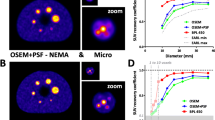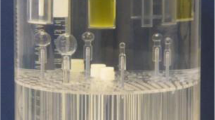Abstract
Objectives
Correction of the “partial volume effect” has been an area of great interest in the recent times in quantitative PET imaging and has been mainly studied with count recovery models based upon phantoms that incorporate hot spheres in a cold background. The goal of this research study was to establish a similar model that is closer to a biological imaging environment, namely hot spheres/lesions in a warm background and to apply this model in a small cohort of patients.
Methods
A NEMA phantom with six spheres (diameters 1–3.7 cm) was filled with 18FDG to give sphere:background activity ratios of 8:1, 6:1, and 4:1 for three different acquisitions on a Philips Allegro scanner. The hot sphere SUVmax and the background average SUV were measured for calculation of recovery coefficients (RCs). Using the RCs, the lesion diameters, and the lesion:background ratio, the SUVmax of 64 lesions from 17 patients with biopsy proven lung cancer were corrected.
Results
The RCs versus sphere diameters produced characteristic logarithmic curves for each phantom (RCs ranged from 80% to 11%). From a cohort of 17 patients with biopsy proven lung cancer, 64 lesions combined had a mean SUVmax of 7.0 and size of 2.5 cm. After partial volume correction of the SUVmax of each lesion, the average SUVmax increased to 15.5.
Conclusions
Hot spheres in a warm background more closely resemble the actual imaging situation in a living subject when compared to hot spheres in a cold background. This method could facilitate generation of equipment specific recovery coefficients for partial volume correction. The clinical implications for the increased accuracy in SUV determination are certainly of potential value in oncologic imaging.



Similar content being viewed by others
References
Soret M, Bacharach SL, Buvat I. Partial-volume effect in PET tumor imaging. J Nucl Med. 2007;48:932–45.
Hoffman EJ, Huang SC, Phelps ME. Quantitation in positron emission computed tomography: effect of object size. J Comput Assist Tomogr. 1979;3:299–3082.
Kessler RM, Ellis JR Jr, Eden M. Analysis of emission tomographic scan data: limitations imposed by resolution and background. J Comput Assist Tomogr. 1984;8:514–22.
Chawluk JB, Alavi A, Dann R, Hurtig HI, Bais S, Kushner MJ, et al. Positron emission tomography in aging and dementia: effect of cerebral atrophy. J Nucl Med. 1987;28:431–7.
Meltzer CC, Leal JP, Mayberg HS, Wagner HN Jr, Frost JJ. Correction of PET data for partial volume effects in human cerebral cortex by MR imaging. J Comput Assist Tomogr. 1990;14:561–70.
Müller-Gärtner HW, Links JM, Prince JL, Bryan RN, McVeigh E, Leal JP, et al. Measurement of radiotracer concentration in brain gray matter using positron emission tomography: MRI-based correction for partial volume effects. J Cereb Blood Flow Metab. 1992;12:571–83.
Rousset OG, Ma Y, Evans AC. Correction for partial volume effects in PET: principle and validation. J Nucl Med. 1998;39:904–11.
Weber W, Schad D, Römer W, Ziegler S, Kruschke C, Herz M, et al. Fluorine-18 FDG-PET in solitary pulmonary nodules: determination of tumor size and correction of partial volume effect. J Nucl Med. 1995;36:95P.
Vesselle H, Schmidt RA, Pugsley JM, Li M, Kohlmyer SG, Vallires E, et al. Lung cancer proliferation correlates with [F-18] fluorodeoxyglucose uptake by positron emission tomography. Clin Cancer Res. 2000;6:3837–44.
Hickeson M, Yun M, Matthies A, Zhuang H, Adam LE, Lacorte L, et al. Use of a corrected standardized uptake value based on the lesion size on CT permits accurate characterization of lung nodules on FDG-PET. Eur J Nucl Med. 2002;29:1639–47.
Daube-Witherspoon ME, Karp JS, Casey ME, DiFilippo FP, Hines H, Muehllehner G, et al. PET performance measurements using the NEMA NU 2-2001 standard. J Nucl Med. 2002;43:1398–409.
Surti S, Karp JS. Imaging characteristics of a 3-dimensional GSO whole-body PET camera. J Nucl Med. 2004;45:1040–9.
National Electrical Manufacturers Association. NEMA Standards Publication NU 22001: performance measurements of positron emission tomographs. Rosslyn, VA: National Electrical Manufacturers Association; 2001.
Adler LP, Crowe JP, Al-Kaisi NK, Sunshine JL. Evaluation of breast masses and axillary lymph nodes with [F-18] 2-deoxy-2-fluoro-D-glucose PET. Radiology. 1993;187:743–50.
Chen CH, Muzic RF Jr, Nelson AD, Adler LP. Simultaneous recovery of size and radioactivity concentration of small spheroids with PET data. J Nucl Med. 1999;40:118–30.
Patz EF Jr, Lowe VJ, Hoffman JM, Paine SS, Burrowes P, Coleman RE, et al. Focal pulmonary abnormalities: evaluation with F-18 fluorodeoxyglucose PET scanning. Radiology. 1993;188:487–90.
Alavi A, Gupta N, Alberini JL, Hickeson M, Adam LE, Bhargava P, et al. PET imaging in nonmalignant thoracic disorders. Semin Nucl Med. 2002;32:293–321.
Nehmeh SA, Erdi YE, Ling CC, Rosenzweig KE, Schoder H, Larson SM, et al. Effect of respiratory gating on quantifying PET images of lung cancer. J Nucl Med. 2002;43:876–81.
Boucher L, Rodrigue S, Lecomte R, Benard F. Respiratory gating for 3-dimensional PET of the thorax: feasibility and initial results. J Nucl Med. 2004;45:214–9.
Author information
Authors and Affiliations
Corresponding author
Rights and permissions
About this article
Cite this article
Srinivas, S.M., Dhurairaj, T., Basu, S. et al. A recovery coefficient method for partial volume correction of PET images. Ann Nucl Med 23, 341–348 (2009). https://doi.org/10.1007/s12149-009-0241-9
Received:
Accepted:
Published:
Issue Date:
DOI: https://doi.org/10.1007/s12149-009-0241-9




